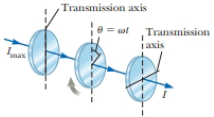
In Figure P37.52, suppose the transmission axes of the left and right polarizing disks are perpendicular to each other. Also, let the center disk be rotated on the common axis with an angular speed ω. Show that if unpolarized light is incident on the left disk with an intensity Imax, the intensity of the beam emerging from the right disk is
This result means that the intensity of the emerging beam is modulated at a rate four times the rate of rotation of the center disk. Suggestion: Use the trigonometric identities
Figure P37.52

Trending nowThis is a popular solution!

Chapter 38 Solutions
EBK PHYSICS FOR SCIENTISTS AND ENGINEER
- 7. Are all scientific theories testable in the commonly understood sense? How does this make you feel? How should you proceed as a scientist or engineer with this understanding?arrow_forwardWhat is an an example of a hypothesis that sounds scientific but is notarrow_forwardWhat is an example of a scientific hypothesisarrow_forward
- Multiverse is called a theory. It has been proposed to account for the apparent and uncanny fine tuning of our own universe. The idea of the multiverse is that there are infinite, distinct universes out there - all with distinct laws of nature and natural constants - and we live in just one of them. Using the accepted definition of the universe being all that there is (matter, space and energy), would you say that multiverse is a scientific theory?arrow_forwardHow is a law usually different than a theoryarrow_forwardA 1.50 mLmL syringe has an inner diameter of 5.00 mmmm, a needle inner diameter of 0.270 mmmm, and a plunger pad diameter (where you place your finger) of 1.2 cmcm. A nurse uses the syringe to inject medicine into a patient whose blood pressure is 140/100. Part A What is the minimum force the nurse needs to apply to the syringe? Express your answer with the appropriate units. View Available Hint(s)for Part A Hint 1for Part A. How to approach the question The force the nurse applies to the syringe can be determined from the fluid pressure and the area of the plunger. The minimum force corresponds to the patient's lowest blood pressure. Use the following equality 760mmofHg=1atm=1.013×10^5Pa760mmofHg=1atm=1.013×10^5Pa.arrow_forward
- A 1.50 mLmL syringe has an inner diameter of 5.00 mmmm, a needle inner diameter of 0.270 mmmm, and a plunger pad diameter (where you place your finger) of 1.2 cmcm. A nurse uses the syringe to inject medicine into a patient whose blood pressure is 140/100. Part A What is the minimum force the nurse needs to apply to the syringe? Express your answer with the appropriate units. View Available Hint(s)for Part A Hint 1for Part A. How to approach the question The force the nurse applies to the syringe can be determined from the fluid pressure and the area of the plunger. The minimum force corresponds to the patient's lowest blood pressure. Use the following equality 760mmofHg=1atm=1.013×10^5Pa760mmofHg=1atm=1.013×10^5Pa.arrow_forwardIs a scientific theory supposed to just be someone's idea about somethingarrow_forwardwhat is the agenda of physicsarrow_forward
 Principles of Physics: A Calculus-Based TextPhysicsISBN:9781133104261Author:Raymond A. Serway, John W. JewettPublisher:Cengage Learning
Principles of Physics: A Calculus-Based TextPhysicsISBN:9781133104261Author:Raymond A. Serway, John W. JewettPublisher:Cengage Learning Physics for Scientists and Engineers with Modern ...PhysicsISBN:9781337553292Author:Raymond A. Serway, John W. JewettPublisher:Cengage Learning
Physics for Scientists and Engineers with Modern ...PhysicsISBN:9781337553292Author:Raymond A. Serway, John W. JewettPublisher:Cengage Learning Physics for Scientists and EngineersPhysicsISBN:9781337553278Author:Raymond A. Serway, John W. JewettPublisher:Cengage Learning
Physics for Scientists and EngineersPhysicsISBN:9781337553278Author:Raymond A. Serway, John W. JewettPublisher:Cengage Learning Physics for Scientists and Engineers: Foundations...PhysicsISBN:9781133939146Author:Katz, Debora M.Publisher:Cengage Learning
Physics for Scientists and Engineers: Foundations...PhysicsISBN:9781133939146Author:Katz, Debora M.Publisher:Cengage Learning College PhysicsPhysicsISBN:9781285737027Author:Raymond A. Serway, Chris VuillePublisher:Cengage Learning
College PhysicsPhysicsISBN:9781285737027Author:Raymond A. Serway, Chris VuillePublisher:Cengage Learning





